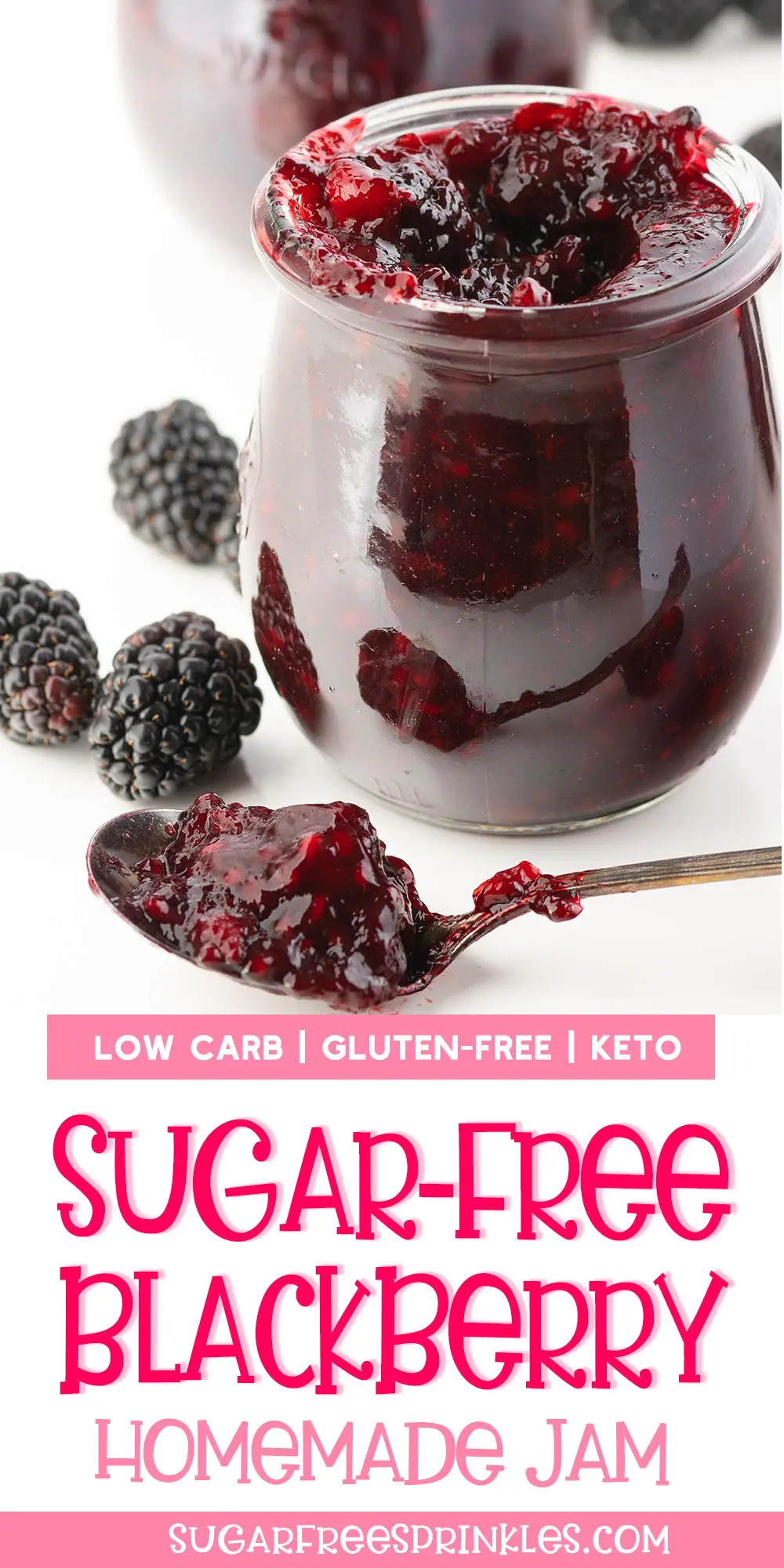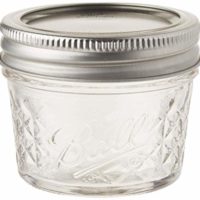This easy sugar-free blackberry jam is amazing. It’s thick, jammy, and sticky! Added bonus, it is completely shelf stable up to a year!
This is a great little recipe to whip up when berries are fresh to enjoy later on during the winter months. Trust me, in the dead of winter you will thank you for making this recipe.

The Easy Low Carb Blackberry jam You want in your pantry
This recipe is:
- Low carb
- Keto-Friendly
- Refined Sugar-Free
- Gluten-Free
- and Vegan
This sugar-free blackberry jam is a very versatile product to have in your pantry. I mean sure, this jam is great on low carb bagels, or gluten-free bread, but it excels in low carb desserts.
- Add to the top of a blackberry cheesecake
- A great mini pie filling
- Make your own low carb pop tarts
- Smear on low carb pancakes
- As filling between layers of a sugar free cake
And the list goes on and on. The best part is making this yourself with fresh ingredients and not paying an arm and a leg for a jar of low-carb jam.

Isn’t Pectin Loaded with Dextrose?
~This post may contain affiliate links. If you click one and make a purchase, I may receive a commission at no additional cost to you. I only ever recommend the ingredients or tools I use for my recipes. You can read more about our disclosure policy here ~
Yes most pectins on the market have dextrose in them.
The pectin I recommend in all my shelf-stable jam recipes does not have any dextrose. The product is called Pomonas 100% pure pectin, and it has been around for a long time. This isn’t a sponsored post either, and I just LOVE this product.
You do not need sugar to make this pectin gel. Stevia, xylitol, erythritol, monk fruit, allulose – it doesn’t matter what sweetener you use, it will work. I tested ALL of them to see what sugar replacement would work best, and they all worked (in one way or other), but allulose was by far the best choice for jam making. I explain that a bit more in the sweetener section.
What about the carb counts for this pectin?
One teaspoon (3 grams) of Pomona’s Universal Pectin contains:
10.2 Total Calories
2.55 grams carbohydrate (from soluble fiber)
2.5 grams of soluble fiber
Since we’re only adding 2 teaspoons to the entire recipe (over 64 servings ), the carb additions are negligible.

Important information about PomoNa’s 100% pectin
There are two types of pectin – pectin that requires sugar to gel, and pectin that requires calcium to gel. There is a whole scientific explanation on Pomona’s website if you’re interested. The package of Pomona’s pectin comes with a small package of calcium powder, no need to buy anything else.
The calcium powder gets mixed into a small jar of water (which lasts forever refrigerated). The calcium water is what gets added to your jam recipes, usually a teaspoon or two at a time.
It could not be easier.
You can find Pomona’s pectin on Amazon, or in health food stores. I paid a little over $8.00 Canadian for a box. I balked at the price but did not realize that one box will make up to 22 half-pints (8 ounce) jars.

Working with PomoNa’s 100% pectin
I found working with this pectin much easier than working with regular pectin. It was much more forgiving. If the jam didn’t gel to my requirements, I could add more calcium water, and it would thicken.
If I added my pectin and sweetener, I could always add more sweetener and continue to process without over thickening the jam. This was great because I wanted to make sure my jam was sweet enough, but I didn’t want to over-sweeten at the start.
Additionally, If you have jars of jam that don’t quite set after they are cooled, you can reprocess them and add either more pectin or more calcium water to get the gel to thicken.
The instructions come in the box, and they are super easy to follow. Pomona’s also has a fantastic website with all kinds of instructions and base recipes for you to work with, including instructions for developing your own recipes.
Quick Pro Tip About Hard Water
Use filtered water in your recipes. If you have hard water (which tends to lean heavy on the calcium already) your jam will thicken more than you want it to – so just be mindful that your water can play a part in how thick your jam gels.
What are the best sweeteners to Use for Low Carb Jam Making?
I tested them all! No kidding, over several months last summer I dove deep into sugar-free jam making and I can say that if you’re going to put the effort in to make jam, use allulose.
Allulose remains sticky, will not crystallize, and creates a classic gel texture. It also imparts no aftertaste. If you want a jam that tastes like jam, use allulose.
Erythritol will harden and turn grainy when cold, as erythritol tends to do. If you are prepared to warm your jam to soften it back up again erythroil will be fine to use.
Xylitol was GREAT, but it does add additional carbs, so not my favourite for that reason.
Truvia, stevia, and Swerve worked fine, but I find they have an aftertaste for me, but that’s personal. If you like Truvia, stevia, or Swerve, absolutely use them. The jam gelled beautifully, and the fruit held its colour and texture – although the jam did crystallize when cold.
If you want to use stevia I suggest checking out Pomona’s website, as working with stevia is a bit different than using granular or powdered sweeteners.
****If you use Xylitol, remember that it is poisonous to dogs and cats! ****

Very important canning Tips
There are a few safety precautions!
This sugar-free blackberry jam requires a full 10-minute rolling boil to seal the jam jars – DO NOT skip this!
- DO NOT skip the lemon juice. Use bottled lemon juice. Fresh lemons vary in acidity, and you want to make sure you get your acidity level correct. Using bottled lemon juice will ensure you’re adding the right amount.
- Do not use a jam bottle larger than 500ML (2 cups).
- When you pull your sugar-free blackberry jam bottles from the canning bath, leave them rest for 24 hours without moving them, or tilting them. Let them set.
- Any jars that did not pop or did not seal properly can be reprocessed in the water bath for another 10 minutes, or stored in the refrigerator for up to 3 weeks.
How to Store your jam
Store these jars of sticky goodness in a cold dark place for up to a year. After the sugar-free blackberry jam jars are opened they can be stored in the fridge for up to 3 weeks.

Want More Sugar-free Shelf-stable Jam recipes?
- How about a fresh blueberry jam that tastes like summer in a jar?
- Or a cherry jam that does double duty as a cherry pie filling?
- Plus a simple strawberry jam perfect for all kinds of low-carb baking recipes.
- Maybe raspberry is your jam?
- We also have an amazing ZERO carb pancake syrup you won’t believe is sugar-free.
Or check out all our jam and sauce recipes!


Sugar-Free Blackberry Jam - Water Bath Canning Method
Sticky, gooey, perfectly gelled sugar-free blackberry jam. You will love the texture and taste of this low-carb jam because it tastes like the real thing!
Ingredients
- 4 cups mashed blackberries (about 8 cups whole or frozen blackberries)
- 2 tsp calcium water
- 2 tsp Pomona’s pectin powder
- 1/4 cup lemon juice
- 1 cup allulose
Instructions
- Wash jars, bands, and lids. Place jars in water bath canner filled halfway with water. Bring water to a boil. Turn off the burner and leave jars in canner until ready to use
- Place lids in water in a small saucepan and heat until water simmers. Keep lids in warm water until ready to use.
- If using fresh blackberries, clean & remove debris before adding to a large saucepan. If using frozen measure and just pour right in.
- Add lemon juice and calcium water and blend in well.
- In a bowl mix allulose and pectin, blend well and set aside.
- Heat the blackberries and as they start to soften, mash with the back of a fork, or use a potato masher. I like to leave a few whole berries in my jam, but mash to the consistency that you like. Bring berries to a boil.
- Add pectin-sweetener mixture, continuing to mix for 1 to 2 minutes to dissolve the pectin while the jam comes back up to a boil. Boil for 1 full minute once the jam reaches the boiling stage.
- Fill jam jars to ¼” from the top. Clean rims with a clean cloth. Add lids.
- Add jars to the water bath canner when the water in the canner reaches a full boil. Boil 10 full minutes (add 1 minute more for every 1,000 ft. above sea level).
- Remove from water. Let jars cool undisturbed for 24 hours.
- Test for seal, if a jar did not seal, you can reprocess it again in the canner for 10 full minutes, or add that jar to the refrigerator for up to 3 weeks.
Notes
- DO NOT skip the lemon juice. Use bottled lemon juice. Fresh lemons vary in acidity, and you want to make sure you get your acidity level correct. Using bottled lemon juice will ensure you’re adding the right amount.
- Do not use a jam bottle larger than 500ML (2 cups).
- When you pull your sugar-free raspberry jam bottles from the canning bath, leave them rest for 24 hours without moving them, or tilting them. Let them set.
- Any jars that did not pop or did not seal properly can be reprocessed in the water bath for another 10 minutes, or stored in the refrigerator for up to 3 weeks.
Recommended Products
As an Amazon Associate and member of other affiliate programs, I earn from qualifying purchases.
Nutrition Information:
Yield: 64 Serving Size: 1Amount Per Serving: Calories: 5Total Fat: 0gSaturated Fat: 0gTrans Fat: 0gUnsaturated Fat: 0gCholesterol: 0mgSodium: 1mgCarbohydrates: 1gNet Carbohydrates: <1gFiber: 1gSugar: 0gProtein: 0g
Nutritional information for the recipe is provided as a courtesy and is approximate only. We cannot guarantee the accuracy of the nutritional information given for any recipe on this site. Erythritol carbs (and sugar alcohols) are not included in carb counts as it has been shown not to impact blood sugar. Net carbs are the total carbs minus fibre.








